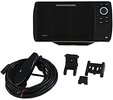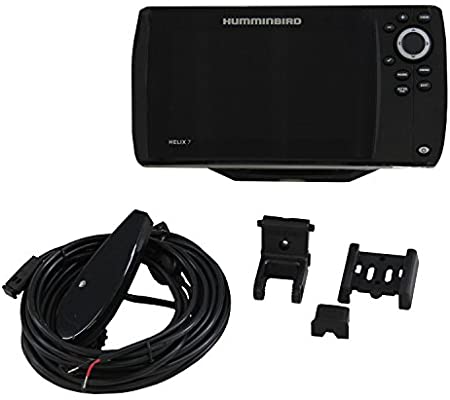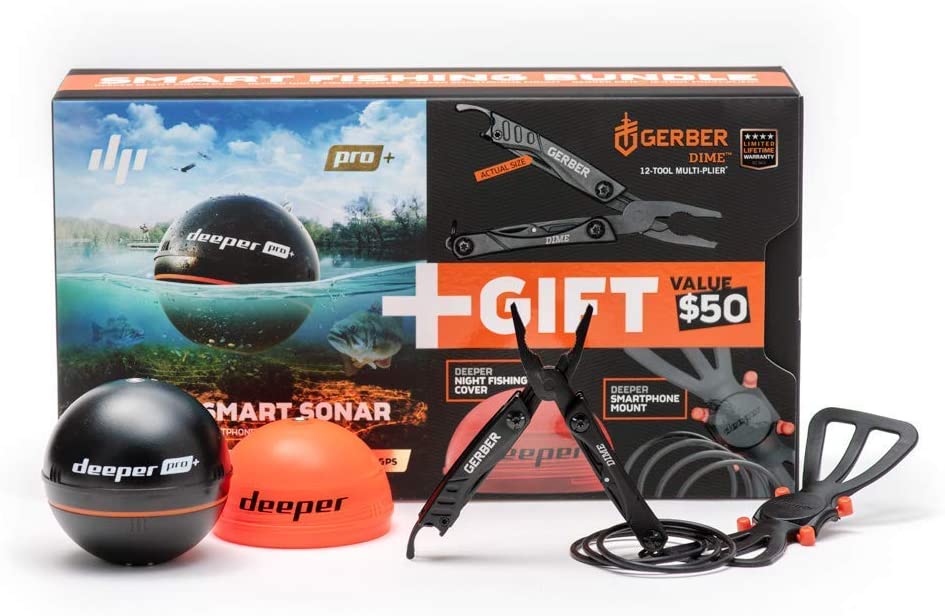One fishing tool that may greatly affect your fishing activity is the fish finder. It may generally help you to locate the spot where most structures are residing. This may generally help you to have an enjoyable, convenient, and easy fishing activity. We reviewed here the best fish finder for bass fishing available in the market.
| BEST FISH FINDER FOR BASS FISHING | PRODUCT NAME | EXPERT RATING | CHECK PRICE |
|---|---|---|---|
 | Garmin ECHOMAP Plus Touchscreen | Check Price | |
 | Humminbird Helix 7 Fish Finder | Check Price | |
 | Deeper PRO Plus Fish Finder | Check Price |
Along with this, we will also share to you the basic reasons why this fishing tool is important to have. Additionally, there are also some common mistakes that most anglers commit when buying a fish finder. So, stay with us until the end and let’s find out what’s the best fish finder in town.
Do I need the best fish finder for bass fishing?
Maybe many of you are still in doubt of having the best fish finder for bass fishing. Well, for those of you who belong in this category, here are the reasons why you need to opt for this kind of fishing tool.
BAIT LOCATOR
Generally, a fish finder may help an angler to locate bait especially in times when it is very difficult to find it on the surface. Oftentimes, baits are usually suspended on the water and can be easily located. However, there are times in which you cannot identify the bait within the ideal spot. With this, it is actually essential to purchase the best fish finder for bass finding and invest in it.
TARGET PARTICULAR SPECIES
Using the best fish finder for bass fishing may basically help you see different fish structures and flat areas underneath the water. Aside from that, it will also help you to determine the water bottom especially in areas where you are not really familiar with fishing.
SAVES TIME AND ENERGY
How can the best fish finder for bass fishing save your time and energy? Obviously, it is when you want to dive off from the kayak and you already know the depths and structures under it through the use of the fish finder. Basically, your time and energy will be saved due to the fact that you won’t be able to guess on the perfect spot to dive into.
Does the best fish finder for bass fishing really help?
The best fish finder for bass fishing is actually effective fishing equipment that lets you locate fish and underwater structures which you never knew existed there. Yet, a single little error in buying this fishing equipment can make it really ineffective, or for sometimes, unusable.
Here are the common mistakes often commit when buying the best fish finder for bass fishing in town:
Fish finder buying mistake #1: Purchasing a fish finder with the absence of GPS
Basically, a fish finder entails various features. Yet, some of these features may be optional like the power wattage, pixel counts, presence of transducers and the screen display. Generally, one of the features that the fish finder cannot be effective without it is GPS.
- Perks of having GPS
- A home travelling tool guide – once you get into an emergency situation in the water, you can easily return back with the help of the GPS device installed in your fishing vessel
- Allows for a unique map creation – Having GPS in your fishing vessel may let you create a personalized map depending on your preference. You can basically mark the spots in your map where structures are found.
- Downside of having GPS
- Generally expensive – the GPS basically adds up to the cost of the best fish finder for bass fishing. Typically, the cost increases by about 50%.
Fish finder buying mistake #2: Going with the one that has a wrong sonar type according on your needs
Sonars have two types, the down scan and the side scan. Basically, the difference lies behind the broadcasting signal of down scan broadcasting. This scanning type transmits underneath the boat directly.
Meanwhile, the side-scan broadcasts an angle signal to the boat sides similar to a fan. Additionally, another choice would be the combination of the down scan and side scan technology.
- Perks of Down Scan
- More focused
- Increase accuracy
- Downsides of Down Scan
- Very powerful
- Perks of Side Scan
- Scan high amounts of water
- Lesser disturbance
- Lesser noise
- Downsides of Side Scan
- Not that effective when it comes to deep water
Fish finder buying mistake #3: Choosing a wireless fish finder for the purpose of the cost
Generally, a wireless or portable fish finder entails much interest in terms of browsing capacity of the best fish finder for bass fishing. Portable devices basically cost less compared to the fixed or mounted fish finders. However, if you will generally base your choice here, it will probably result in inconvenience and elevated overall cost.
- Perks of portable fish finder
- Entails various application
- Transducers have plenty of purposes
- No need for installation
- Lesser cost
- Downsides of portable fish finder
- Not stable
- Inconsistent
How do you detect fish?
The sonar system acts primarily to locate fishes and underwater structure. Basically, this kind of system applies to a similar approach with the other sonar systems. Their actions primarily include the transmission of sound impulses, measurement of the time for return echoing, and computation of the distance to the objects.
Generally, units categorized under the fish find sonar, they transmit and receive signals in high frequency in every second. Additionally, they focus the sound concentration into a beam that comes from a transducer. This fish-finding sonar unit also contains visual displays that print out echoes.
The fish finder generally detects fishes underneath typically by detecting the air within their swim bladders. Actually, the air confined in this swim bladder alters the path of sound and reflects the energy back. Subsequently, the fish finding tool determines the energy being reflected and converts it eventually into a fish photo displayed on the screen.
Moreover, the photos created on the display are formed via arches through boat or fish movement. Once the transducers send sounds, it is being focused into a beam. Aside from that, the sound goes deep down the water and as the beam distributes out, it generally covers a wider area.
Fish that go toward the cone may generally give off the sound returning to the transducer. The sound returned, or what we know as an echo, shows on the chart of the sonar screen. Additionally, the group of fish will be detected as various shapes or the structure. However, this depends on the amount of group is within the transducer’s coverage.
Further, the creation of fish arch formation began once the fish moves toward the sonar beam. And on the right-side display, a mark basically appears the moment the fish enters the outer part of the cone.
In addition, as the fish goes into the cone, the length between the transducer and the fish reduces. With this, the mark starts to form up a curve. The curve will then form downward once the fish goes further from the transducer.
What to look for when buying the best fish finder for bass fishing
Here are the following things that you must consider when you want to buy the best fish finder for bass fishing:
✔ Mounting ability – portable vs. fixed
Actually, stories behind the portable best fish finder for bass fishing already revolve within the industry. It is basically the most ideal and budget-friendly alternative to those costly fish finders. Generally, the expensive fish finders demand a fixed mounting mode.
These types of fish finders are really common for use by fishing kayaks novice. Most of them basically purchase these fishing tools as designated fish finders for a kayak.
However, portable fish finders are becoming popular these days. Yet, the advanced technology behind the conventional versions of a mounted fish finder is really unbeatable.
The fixed mountable version permits its mounting in any way you want as well as hiding its wires with ease and convenience. Just simply place them under the floorboards.
Moreover, the fixed versions of the best fish finder for bass fishing achieve greater stability compared to the portable one. This basically allows utilization of the suction cups to maintain their position in place.
Additionally, they are more consistent, unlike the portable fish finder device. However, its downside includes easy fall out of this model at a high speed.
On the other hand, the portable models tend to be more attractive and a better choice for a budget-friendly fish locator. Yet, both of the portable and fixed versions are applicable for small and big boats.
✔ Durability
One of the primary things to consider when looking for the best fish finder for bass fishing is the durability. Generally, high-quality products are capable of handling various wear and tear situations from fishing activities. Moreover, ensure that the fish finder model is secured while mounted and doesn’t break up easily.
✔ Frequency
Generally, the best fish finder for bass fishing works well on a really low kHz or a truly high rate. Those that are at the minimum part of the spectrum, they usually perform around 50kHz. Yet, the fish finders with frequency ranges of around 192kHz to 200kHz are those that are under the upper scale.
However, the range of frequency basically varies on the fishing location. In addition, every frequency choice entails their natural advantages. Basically, water can absorb high frequencies in order for the scanning sonar to work on the lower scale and go deeper.
Moreover, the imaging sonars work well in shallow waters as it gives off higher frequencies. Although, those high-frequency models are not capable of going deep, yet, they are less prone to distractions and show off more definition. Aside from that, fishing in shallow and deep water requires purchasing the best fish finder for bass findings that can return back and forth among the frequency.
✔ GPS Affiliated
GPS or also known as the Global Positioning System that is widely accepted for its utilization on the road. With this, its use is similarly convenient in water. The use of GPS can generally help you to determine your route back to the land easily.
Further, lots of updated models nowadays already have GPS integrated inside. Moreover, those devices with GPS are generally combination models. Fishing tools with this feature work well on chart plotting and depth sounding.
Additionally, fish finders with GPS are capable of entering various waypoints. Having this, you can mark various structures, ramps, and fish. It is generally important to remember this feature as it is an important one to look for a fish finder for bass fishing.
✔ Scanning
Basically, there are two methods on how scanning works on the best fish finder for bass fishing. These methods include the downscan and sidescan.
A downscan generally permits the user to identify excellent detail and spot fishes. These types of scanning sonars give more accuracy. However, they are usually more powerful within shallow waters.
Moreover, the sidescan allows the scanning of sufficient amounts of water that covers a bigger area. Additionally, you are not required to move the fishing vessel directly to the fishing area you are scanning. Aside from that, with the sides, the best fish finder for bass fishing can also scan calm water.
✔ Transducer
Basically, the transducer is the fish finder component that acts to transmit sound waves. This generally offers an idea regarding underneath lurking within the water’s surface. The transducer generally performs similarly with a radio antenna as it produces sound waves and gets back echoes.
Moreover, a transducer can be mounted in various locations that permit its sitting in the most convenient part of the best fish finder for bass fishing. The location of the transducer is basically on the trolling motor or transom or at the inner compartment of the hull.
The transducer choices generally vary on the cone angle, that’s why it is better to opt for the best fish finder for bass fishing that compliments well with bass. Always remember that transducers having wider angles are basically less effective in deep water. Meanwhile, it provides wider imagery of the shallow water.
✔ Display
Another great feature of the best fish finder for bass fishing is the display. It works basically in the same way an underwater camera operates. When looking for this feature, focus on the size of the display, its color, contrast, and details.
Moreover, another important aspect for consideration in terms of the display is the count of pixels. It is also a generally important concern to know that the more pixels the display offers, the clearer and smoother the image will become. In addition, a large size of the screen also elevates the ease of reading.
Top 3 Best Fish Finder for Bass Fishing
OUR TOP PICK: Garmin ECHOMAP Plus Touchscreen

Product Name: Garmin ECHOMAP Plus Touchscreen
Product Description: The first on our list of the best fish finders for bass fishing is the Garmin ECHOMAP Plus Touchscreen. This version of Garmin Echomap contains extra features which you cannot see in the previous models. The features inside this new model are the WiFi, touchscreen technology, ActiveCaptain compatibility, and SailAssist. Moreover, Garmin Echomap Plus Touchscreen is a fish finder that can either be fixed or mountable. Basically, the good thing about Garmin Echomap Plus Touchscreen entails a comprehensive fishing approach, thanks to the GT22 transducer that it has. The CHIRP that it contains is of two types - the CHIRP ClearVü scanning sonar and the conventional type of CHIRP sonar. Generally, the combination of these two CHIRPs produces crisp and clear quality images at any depth level.
Brand: Garmin
SKU: B076W2QMKN
MPN: 010-01893-01
Offer price: 599.99
Currency: USD
Availability: InStock
Offer URL: https://amzn.to/3vrxZ8p
Valid until: 2025-02-16
-
Flexibility
-
Water Resistance
-
Readability
Overall
Summary
Due to the built-in WiFi installed in Garmin Echomap Plus, the OneChart can be easily accessible. Simply pair it to the ActiveCaptain app that is freely available. However, this best fish finder for bass fishing also permits the user to purchase a separate chart or to download it. Buying this best fish finder for bass fishing will result in a high-resolution image and allows for excellent navigation.
Pros
-
Produces clear image
-
User-friendly
-
Built-in WiFi
-
Allows real-time mapping
-
Lightweight
-
Large display
Cons
- No side imaging option
RUNNER-UP
Humminbird Helix 7 Fish Finder

Another best fish finder for bass fishing on our list is the Humminbird Helix 7 Fish Finder. This is another flexible fish finder that we have. Using the Humminbird Helix 7 Fish Finder, you will be able to basically see a clear sight of the underwater.
With its 7″ ultra-widescreen display, one can generally achieve an amazing view of the fish. Additionally, this best fish finder for bass fishing contains a MEGA side imaging function. This feature actually allows you to cover up to 125 feet on both sides of the fishing vessel.
Aside from that, another good feature of the Humminbird Helix 7 Fish Finder is its Dual Spectrum CHIRP sonar content. The action of this component is basically to boost the target separation and offers an achievable 2D experience with the sonar as well as great fish arches.
Moreover, Humminbird Helix 7 Fish Finder has a built-in Bluetooth that permits its pairing to a smartphone device. The pairing will give updates, pop-ups, and supreme unit control. Another advantage that you may get from using this best fish finder for bass fishing is its connection to Ethernet Networking that allows sharing.
Amazing features:
- A screen with 7″ display that has s 800×400 image resolution
- CHIRP with dual spectrum type
- Contains a CHIRP sonar with a depth of 1,500
- Has a GPS that is built internally
- Intended slot for Single Micro SD
- Compatible with a different type of cartographies
- Networking using Bluetooth and Ethernet
- Keypad controller available
- Has an AutoChart Live function for real-time map creation
- Compatible with Navionics
- Includes mounting bracket of gimbal type, mounting hardware, transducer, and power cable
Generally, imaging resolution and accuracy from this best fish finder for bass fishing upgrades to the next level. Acquiring Humminbird Helix 7 Fish Finder will allow you to experience all of these excellent features at an affordable price.
Deeper PRO Plus Fish Finder

The thing that makes Deeper PRO Plus Fish Finder the best fish finder for bass fishing is its wireless or portable feature. Generally, the Deeper PRO Plus Fish Finder is a real game-changer in the world of sonar technology.
Moreover, once you use this kind of fish finder, you do not need a boat that has a fixed transducer. This Deeper PRO Plus makes use of sonar when targeting a fish of all types. Once you wind in, you can also scan the river bottom at the same time.
The sonar data will eventually transmit the data directly to your phone through its WiFi connectivity. Moreover, the smartphone app is generally available for saving purposes of the scanned data. Additionally, it allows you to detect underwater figures like fishes and structures.
Amazing features:
- The range of WiFi offer is about 330 feet or 100 meter
- The compact size of 2.5 inches or 6.5 centimetres in diameter
- It is compatible with iOS and Android versions
- Weighs 100 grams or 3.5 ounce
- Battery operated using a rechargeable 3.7v Lithium Polymer which lasts for 6 hours of continuous usage
- Contains an integrated GPS
- With Waypoints marker
- Has a COG or Course over Ground
The Deeper PRO Plus Fish Finder is the best fish finder for bass fishing which is actually portable in its wireless form. Because of this, it is generally applicable for use for land-based or those anglers of kayak who seek for catch rate improvement.
Frequently Asked Questions:
Q: What is the difference between chirp and sonar?
A: The CHIRP type of fish finders send a longer pulse compared to the conventional sonar which places extra energy inside the water column. Additionally, the CHIRP type contains a real broadband frequency coverage of about 117 kHz. Rather than transmitting one frequency similar to the conventional 2D sonar, the CHIRP device sends sweeping frequencies of coverage.
Q: What kHz to use on a fish finder?
A: Basically, the ultrasound frequency of most fish finders come in 15 kHz to 200 kHz. Yet, most of the traditional fish finders intended for recreational purposes use around 50 kHz to 200 kHz.
Q: How deep do fish finders go?
A: Usually, the maximum depth that fish finders usually utilize are the lower frequencies. The recommended frequency range is around 200kHz or up until 800 kHz which is applicable for the depth of 200′ and 80 kHz or 50 kHz.
Q: Do fish finders work in shallow water?
A: Generally, a fish finder of sonar type with a frequency of around 200 kHz or higher performs better in shallow water. Once the frequency is higher, the resolution that will be displayed is also higher. Additionally, this range of frequency will also allow you to place the boat appropriately over the fish.
Q: Is a fish finder worth it on a kayak?
A: A fish finder with GPS attachment on the kayak can actually offer unique advantages for fishermen. The perks of using a fish finder typically entail the identification of underwater figures and fishing baits. Additionally, mapping the way back to the site really quick can also be determined.
Final Thoughts
The best fish finder for bass fishing may actually depend on many factors. One factor is the mounting ability of this fishing tool. Other things to consider include its scanning capacity, GPS integration, the display, and other standard features that may come along.
Moreover, when buying this fishing tool, also take into account the cost. A high-quality fish finder is a good investment which may be your best fishing buddy for the long run.


